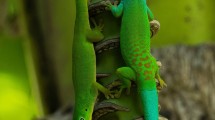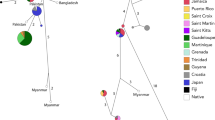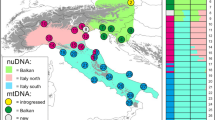Abstract
The successful introduction of the common genet (Genetta genetta) into Europe has been traditionally associated to the Muslim invasion of Iberia, although diverse evidence suggested an earlier arrival. In this study, we assessed genetic variation at 11 microsatellite loci in 199 individuals from the Mediterranean Basin and used approximate Bayesian computation (ABC) combining genotypes and published mitochondrial sequences. Our objectives were to (1) test alternative scenarios of introduction of the species in Europe, (2) re-assess the mitochondrial signatures of ‘introduction hotspots’ in Iberia, and (3) evaluate how post-introduction demographic processes have shaped genetic structure in the invaded range. ABC estimates favored a scenario of independent introductions from Maghreb into the Balearic Isl. and Iberia; the latter was dated between the Upper Palaeolithic and the end of Phoenicians’ influence. Patterns of genotypic diversity broadened the Andalusian introduction hotspot to the antique Tartessos Kingdom and suggested multiple introductions and/or long-term genetic drift. The best fit ABC scenario implied a natural spread from Iberia to France, but was in potential conflict with our delimitation of two genetic clusters (France and Iberia) in continental Europe. In fact, southwestern France populations showed a fair proportion of alleles shared with Maghreb and low levels of heterozygosity that may reflect subsequent introduction from Iberia, in line with the high error rates in favor of this alternative scenario. Significant patterns of isolation-by-distance among individuals within both genetic clusters are suggestive of natural dispersal from both Iberian and French introduction sites resulting in a secondary contact zone in northern Iberia. Overall, our study strongly suggests that the common genet was intentionally introduced in southern Iberia at a time antedating the Muslim invasion, possibly via Phoenicians’ commercial routes. Subsequent introduction in France, long-term genetic drift and admixture likely shaped the species genetic variation currently observed in continental Europe.




Similar content being viewed by others
References
Allendorf FW, Lundquist LL (2003) Introduction: population biology, evolution, and control of invasive species. Conserv Biol 17:24–30
Amigues S (1999) Les belettes de Tartessos. Anthropozool 29:55–64
Beaumont MA (2010) Approximate Bayesian computation in evolution and ecology. Annu Rev Ecol Evol Syst 41:379–406
Blondel J, Vigne JD (1993) Space, time, and man as determinants of diversity of birds and mammals in the Mediterranean region. In: Ricklefs RE, Schluter D (eds) Species diversity in ecological communities: historical and geographical perspectives. The University of Chicago Press, Chicago and London, pp 135–146
Bowcock AM, Ruiz-Linares A, Tomfohrde J et al (1994) High resolution of human evolutionary trees with polymorphic microsatellites. Nature 368:455–457
Broders HG, Mahoney SP, Montevecchi WA et al (1999) Population genetic structure and the effect of founder events on the genetic variability of moose, Alces alces, in Canada. Mol Ecol 8:1309–1315
Chamorro JG (1987) Survey of archaeological research on Tartessos. Am J Archaeol 91:197–232
Ciolek TM (2011) 1999–present. Georeferenced historical transport/travel/communication routes and nodes. OWTRAD dromographic digital data archives (ODDDA): old world trade routes (OWTRAD) Project. www.ciolek.com—Asia Pacific Research Online, Canberra, Australia
Clevenger A (1993) Status of martens and genets in the Balearic and Pityusic Islands, Spain. Small Carniv Conserv 9:18–19
Cornuet J-M, Ravigne V, Estoup A (2010) Inference on population history and model checking using DNA sequence and microsatellite data with the software DIYABC (v1.0). BMC Bioinfo 11:401
Cornuet JM, Pudlo P, Veyssier J et al (2013) DIYABC version 2.0: A user-friendly software for inferring population history through approximate Bayesian computations using microsatellite, DNA sequence and SNP data. Institut National de la Recherche Agronomique, Campus International de Baillarguet, Saint-Gély-du-Fesc
Cornuet J-M, Pudlo P, Veyssier J et al (2014) DIYABC v2.0: a software to make approximate Bayesian computation inferences about population history using single nucleotide polymorphism, DNA sequence and microsatellite data. Bioinformatics 30:1187–1189
Crawford KM, Whitney KD (2010) Population genetic diversity influences colonization success. Mol Ecol 19:1253–1263
Cucchi T, Vigne J-D, Auffray J-C (2005) First occurrence of the house mouse (Mus musculus domesticus Schwarz & Schwarz, 1943) in the Western Mediterranean: a zooarchaeological revision of subfossil occurrences. Biol J Linn Soc 84:429–445
Davies N, Villablanca FX, Roderick GK (1999) Determining the source of individuals: multilocus genotyping in nonequilibrium population genetics. TREE 14:17–21
Delibes M (1977) Sobre las ginetas de la isla de Ibiza (Genetta genetta isabelae n. ssp.). Doñana, Acta Vertebrata 4:139–160
Delibes M, Gaubert P (2013) Genetta genetta common genet (small-spotted genet). In: Kingdon JS, Hoffmann M (eds) The mammals of Africa: carnivores, pangolins, equids and rhinoceroses edn, vol 5. Bloomsburry Publishing, London, pp 224–229
Delort R (1978) Le commerce des fourrures en Occident à la fin du Moyen-Âge. Ecole Française de Rome, Palais Farnèse
Derricourt R (2005) Getting “out of Africa”: sea crossings, land crossings and culture in the hominin migrations. JWP 19:119–132
Dieringer D, Schlötterer C (2003) Microsatellite analyser (MSA): a platform independent analysis tool for large microsatellite data sets. Mol Ecol Not 3:167–169
Dlugosch KM, Parker IM (2008) Founding events in species invasions: genetic variation, adaptive evolution, and the role of multiple introductions. Mol Ecol 17:431–449
Dobson M (1998) Mammal distributions in the western Mediterranean: the role of human intervention. Mamm Rev 28:77–88
Earl DA, VonHoldt BM (2012) STRUCTURE HARVESTER: a website and program for visualizing STRUCTURE output and implementing the Evanno method. Conserv Genet Resour 4:359–361
Elayi J (2013) Histoire de la Phénicie. Perrin, Paris
Estoup A, Guillemaud T (2010) Reconstructing routes of invasion using genetic data: why, how and so what? Mol Ecol 19:4113–4130
Estoup A, Jarne P, Cornuet J-M (2002) Homoplasy and mutation model at microsatellite loci and their consequences for population genetics analysis. Mol Ecol 11:1591–1604
Estoup A, Lombaert E, Marin J-M et al (2012) Estimation of demo-genetic model probabilities with approximate Bayesian computation using linear discriminant analysis on summary statistics. Mol Ecol Resour 12:846–855
Evanno G, Regnaut S, Goudet J (2005) Detecting the number of clusters of individuals using the software structure: a simulation study. Mol Ecol Notes 14:2611–2620
Excoffier L, Laval G, Schneider S (2005) Arlequin ver. 3.0: an integrated software package for population genetics data analysis. Evol Bioinform Online 1:47–50
Falush D, Stephens M, Pritchard J (2003) Inference of population structure using multilocus genotype data: linked loci and correlated allele frequencies. Genetics 164:1567–1587
Ferrando A, Lecis R, Domingo-Roura X et al (2008) Genetic diversity and individual identification of reintroduced otters (Lutra lutra) in north-eastern Spain by DNA genotyping of spraints. Conserv Biol 9:129–139
Forsman A, Ahnesjö J, Caesar S et al (2008) A model of ecological and evolutionary consequences of color polymorphism. Ecology 89:34–40
Fountain T, Duvaux L, Horsburgh G et al (2014) Human-facilitated metapopulation dynamics in an emerging pest species, Cimex lectularius. Mol Ecol 23:1071–1084
Frankham R (1998) Inbreeding and extinction: Island populations. Conserv Biol 12:665–675
Frantz AC, Cellina S, Krier A et al (2009) Using spatial Bayesian methods to determine the genetic structure of a continuously distributed population: clusters or isolation by distance? J Appl Ecol 46:493–505
Gaubert P, Mézan-Muxart V (2010) Where have the ‘black genets’ gone? A likely restriction of melanistic cases of the common genet (Genetta genetta) to its introduced range. Mamm Biol 75:353–357
Gaubert P, del Cerro I, Palomares F et al (2008a) Development and characterization of 11 microsatellite loci in a historically introduced carnivoran, the common genet (Genetta genetta). Mol Ecol Resour 8:1375–1377
Gaubert P, Jiguet F, Bayle P et al (2008b) Has the common genet (Genetta genetta) spread into south-eastern France and Italy? Ital J Zool 75:43–57
Gaubert P, Godoy JA, del Cerro I et al (2009) Early phases of a successful invasion: mitochondrial phylogeography of the common genet (Genetta genetta) within the Mediterranean Basin. Biol Invasion 11:523–546
Gaubert P, Machordom A, Morales A et al (2011) Comparative phylogeography of two African carnivorans presumably introduced into Europe: disentangling natural versus human-mediated dispersal across the Strait of Gibraltar. J Biogeogr 38:341–358
Goudet J (1999) PCA-GEN. version 1.2. Lausanne, Switzerland. www.unil.ch/izea/softwares/pcagen.html
Goudet J (2001) FSTAT, version 2.9.3. A program to estimate and test gene diversities and fixation indices. Lausanne University, Lausanne, Switzerland. http://www2.unil.ch/popgen/softwares/fstat.htm
Guillot G, Estoup A, Mortier F et al (2005a) A spatial statistical model for landscape genetics. Genetics 170:1261–1280
Guillot G, Mortier F, Estoup A (2005b) GENELAND: a computer package for landscape genetics. Mol Ecol Notes 5:712–715
Guo SW, Thompson EA (1992) Performing the exact tests of Hardy–Weinberg proportion for multiple alleles. Biometrics 48:361–372
Henry P, Le Lay G, Goudet J et al (2009) Reduced genetic diversity, increased isolation and multiple introductions of invasive giant hogweed in the western Swiss Alps. Mol Ecol 18:2819–2831
Higuchi R, von Beroldingen CH, Sensabaugh GF et al (1988) DNA typing form single hairs. Nature 332:543–546
Jones EP, Eager HM, Gabriel SI et al (2013) Genetic tracking of mice and other bioproxies to infer human history. Trends Genet 29:298–308
Kalinowski ST (2005) HP-RARE 1.0: a computer program for performing rarefaction on measures of allelic richness. Mol Ecol Notes 5:187–189
Khamis FM, Karam N, Ekesi S et al (2009) Uncovering the tracks of a recent and rapid invasion: the case of the fruit fly pest Bactrocera invadens (Diptera: Tephritidae) in Africa. Mol Ecol 18:4798–4810
Kolbe JJ, Glor RE, Rodriguez Schettino L et al (2004) Genetic variation increases during biological invasion by a Cuban lizard. Nature 431:177–181
Lebarbenchon C, Poitevin F, Arnal V et al (2010) Phylogeography of the weasel (Mustela nivalis) in the western-Palaearctic region: combined effects of glacial events and human movements. Heredity 105:449–462
Lee CE (2002) Evolutionary genetics of invasive species. TREE 17:386–391
Masseti M (1995) Quaternary biogeography of the Mustelidae family on the Mediterranean islands. Hystrix 7:17–34
Masseti M (2009) Mammals of the Mediterranean Islands: homogenisation and the loss of biodiversity. Mammalia 73:169–202
Meirmans PG (2012) The trouble with isolation by distance. Mol Ecol 21:2839–2846
Mézan-Muxart V (2010) Genette et janette: devises de Jeanne de France au XVe siècle. Reinardus 22:104–125
Morales A (1994) Earliest genets in Europe. Nature 370:512–513
Morales Muñiz DC (2000) La fauna exótica en la Península Ibérica: apuntes para el estudio del coleccionismo animal en el Medievo hispánico. Espacio, Tiempo y Forma, Serie III, Ha Medieval 13:233–270
Moscati S (1996) La grande Cadice dei Fenici. Accademia nazionale dei Lincei, Roma
Müllenbach R, Lagoda PJ, Welter C (1989) An efficient salt-chloroform extraction of DNA from blood and tissues. Trends Genet 5:391
Muñiz AM, Pecharroman MAC, Carrasquilla FH et al (1995) Of mice and sparrows: commensal faunas from the Iberian Iron Age in the Duero valley (Central Spain). Int J Osteoarchaeol 5:127–138
Nei M, Maruyama T, Chakraborty R (1975) The bottleneck effect and genetic variability in populations. Evolution 29:1–10
Oksanen JF, Blanchet G, Kindt R et al (2013) vegan: Community Ecology Package. R package version 2.0-8. http://CRAN.R-project.org/package=vegan
Peakall R, Smouse PE (2006) GENALEX 6: genetic analysis in Excel. Population genetic software for teaching and research. Mol Ecol Notes 6:288–295
Pritchard JK, Stephens M, Donnelly P (2000) Inference of population structure using multilocus genotype data. Genetics 155:945–959
R Development Core Team (2010) R: a language and environment for statistical computing. R Foundation for Statistical Computing, Vienna
Raymond M, Rousset F (1995) An exact test for population differentiation. Evolution 49:1280–1283
Roman J, Darling JA (2007) Paradox lost: genetic diversity and the success of aquatic invasions. TREE 22:454–464
Rousset F (2000) Genetic differentiation between individuals. J Evol Biol 13:58–62
Rousset F (2008) GenePop’007: a complete re-implementation of the GenePop software for Windows and Linux. Mol Ecol Resour 8:103–106
Sakai AK, Allendorf FW, Holt JS et al (2001) The population biology of invasive species. Ann Rev Ecol Syst 32:305–332
Sambrook E, Fritsch F, Maniatis T (1989) Molecular cloning. Cold Spring Harbor Press, New York
Searle JB (2008) The genetics of mammalian invasions: a review. Wild Res 35:185–192
Searle JB, Jamieson PM, Gündüz İ et al (2009) The diverse origins of New Zealand house mice. Proc R Soc B Biol Sci 276:209–217
Segert S (2007) Phoenician and Punic morphology. In: Kaye AS (ed) Morphology of Asia and Africa, vol 1. Eisenbrauns, Winona Lake, pp 75–84
Smouse PE, Peakall R (1999) Spatial autocorrelation analysis of individual multiallele and multilocus genetic structure. Heredity 82:561–573
Sunnåker M, Busetto AG, Numminen E et al (2013) Approximate Bayesian computation. PLoS Comput Biol 9:e1002803
Taberlet P, Griffin S, Goossens B, Questiau S, Manceau V, Escaravage N, Waits LP, Bouvet J (1996) Reliable genotyping of samples with very low DNA quantities using PCR. Nucl Acids Res 24:3189–3194
Templeton AR (2009) Statistical hypothesis testing in intraspecific phylogeography: nested clade phylogeographical analysis vs. approximate Bayesian computation. Mol Ecol 18:319–331
Tomàs C, Jiménez G, Picornell A et al (2006) Differential maternal and paternal contributions to the genetic pool of Ibiza Island, Balearic Archipelago. Am J Phys Anthropol 129:268–278
Tsutsui ND, Suarez AV, Holway DA et al (2000) Reduced genetic variation and the success of an invasive species. Proc Natl Acad Sci USA 97:5948–5953
Van Oosterhout C, Hutchinson WF, Wills DPM et al (2004) Micro-checker: software for identifying and correcting genotyping errors in microsatellite data. Mol Ecol Notes 4:535–538
Verhoeven KJF, Simonsen KL, McIntyre LM (2005) Implementing false discovery rate control: increasing your power. Oikos 108:643–647
Verhoeven KJF, Macel M, Wolfe LM et al (2011) Population admixture, biological invasions and the balance between local adaptation and inbreeding depression. Proc R Soc B Biol Sci 278:2–8
Vigne J-D, Zazzo A, Saliège J-F et al (2009) Pre-Neolithic wild boar management and introduction to Cyprus more than 11,400 years ago. Proc Natl Acad Sci USA 106:16135–16138
Weir BS, Cockerham CC (1984) Estimating F-statistics for the analysis of population structure. Evolution 38:1358–1370
Acknowledgments
Author information
Authors and Affiliations
Corresponding author
Electronic supplementary material
Below is the link to the electronic supplementary material.
10530_2015_846_MOESM1_ESM.xls
Detailed list of the samples used in this study, together with their genotypes and mitochondrial sequences. Numbering of mitochondrial sequences (‘Hapx’) refer to haplotype combinations in Gaubert et al. (2011) (XLS 100 kb)
10530_2015_846_MOESM2_ESM.docx
Prior and posterior distributions of model parameters estimated for scenario 3 and two different population groupings (sets 1 and 2) from simulations using DIYABC. Historical parameters have been constrained as follows: t4>tb; N2>N2b; N4>N4b; t4>dk; t3>dj.(DOCX 16 kb)
10530_2015_846_MOESM3_ESM.docx
Principal component analysis of summary statistics of 600,000 simulated data sets generated with six demographic scenarios and two different population groupings (sets 1 and 2). Observed dataset (large yellow dot) is projected on the plane formed by the first two principal components. Above: set1; below: set2. (PDF 139 kb)
10530_2015_846_MOESM4_ESM.pdf
Geneland clustering analysis among populations of the common genet in the Mediterranean Basin (K=4). Clusters are the same as delineated by STRUCTURE. Circle in clusters 1 and 2 graphical representations show admixed populations detected in northwestern Iberia. (PDF 140 kb)
10530_2015_846_MOESM5_ESM.docx
Genetic differentiation (F ST ) among the geographic populations of the common genet. See Table 1 for population acronyms. (DOCX 16 kb)
10530_2015_846_MOESM6_ESM.docx
Graphical representation of the relative posterior probabilities of the six scenarios of introduction of the common genet in Europe calculated through a polychotomous logistic regression from the 0.1% of simulated data sets most closely resembling the observed data (direct method). Left: set1; right: set2. (DOCX 44 kb)
10530_2015_846_MOESM7_ESM.docx
Principal component analysis of summary statistics from 500 pseudo-observed datasets generated from the posterior predictive distribution of scenario 3 (large blue dots), plotted along with summary statistics of simulations generated from priors of scenario 3 (small blue dots). The observed dataset (large yellow dot) is projected on the plane formed by the first two principal components. Above: set1; below: set2. (DOCX 130 kb)
Rights and permissions
About this article
Cite this article
Gaubert, P., Del Cerro, I., Centeno-Cuadros, A. et al. Tracing historical introductions in the Mediterranean Basin: the success story of the common genet (Genetta genetta) in Europe. Biol Invasions 17, 1897–1913 (2015). https://doi.org/10.1007/s10530-015-0846-y
Received:
Accepted:
Published:
Issue Date:
DOI: https://doi.org/10.1007/s10530-015-0846-y




